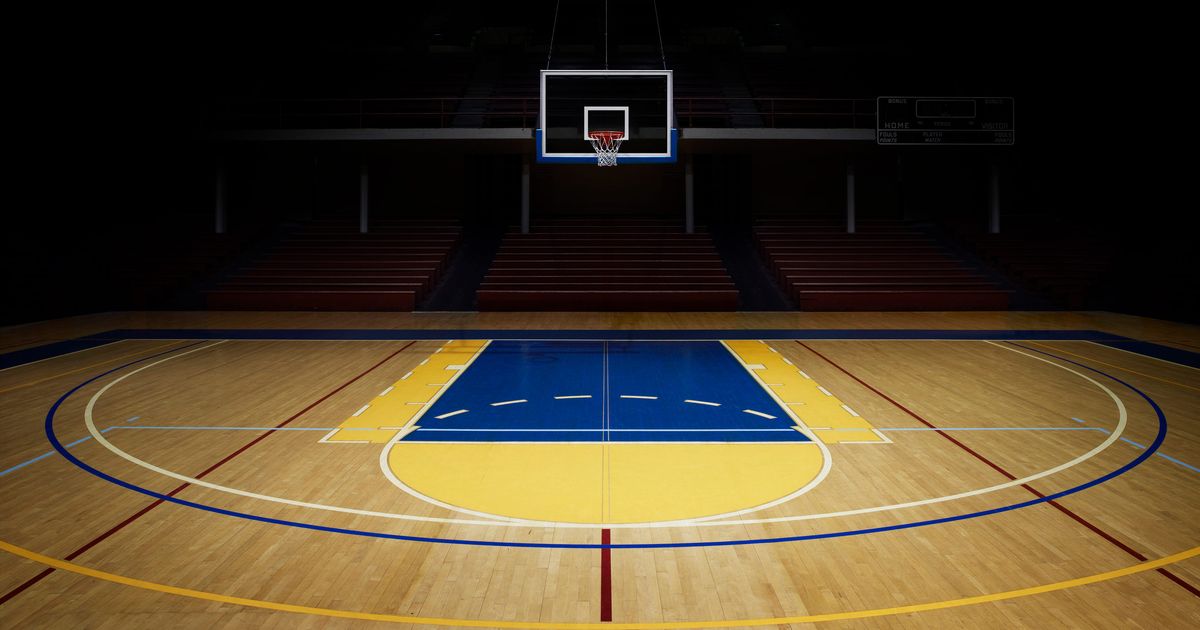Home »
Misc »
How much space do you need for a basketball court
How much space do you need for a basketball court
Everything You Need to Know About Basketball Court Dimensions
Of the two major American-invented sports — baseball and basketball — only one has gained worldwide popularity. We play baseball across parts of the globe, but we play basketball worldwide. You can play with as few as two people and as many as ten. Shoot hoops indoors and outdoors and on any surface hard or flat enough to bounce a ball.
Indoor courts are usually made from hardwood, though other, more easily-maintained surfaces are gaining in popularity. Outdoor courts can be either asphalt or concrete. You can put a permanent basketball court just about anywhere you would like. Don’t have the room for a full-length court? Fitting just a half court into your driveway, backyard, or commercial gym would be just as useful.
So, have a space in mind and wondering “What are the dimensions of a basketball court?” Let’s take a look at the standard sizes for every level of basketball, from high school all the way up through international competition.![]()
NBA Basketball Court DimensionsThe National Basketball Association, better known as the NBA, boasts the largest court dimensions of any level of basketball — domestic or international. The outer dimensions are 94 feet long by 50 feet wide. The half court line is, as the name would suggest, halfway between each end line. In the middle of the half court line is a tip-off circle with a six-foot radius, which often sports the home team’s logo.
The key is 16 feet wide and 19 feet from the baseline to the foul line. A semicircle with a six-foot radius extends from the foul line. Some courts have the other side of the half-circle drawn in a dotted line inside the key to complete the circle and create a clear boundary for any jump balls.
The backboard protrudes four feet out from the baseline, and the rim of the basket hangs 10 feet off the ground. Subtracting the four feet overhang from the 19-foot length of the key, we get the familiar 15-foot distance from the foul line to the front of the backboard.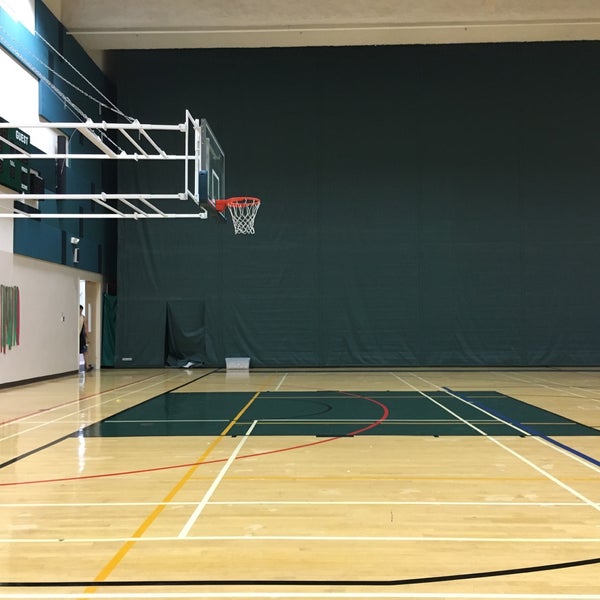 It’s a misconception that the foul line is 15 feet from the center of the basket. The backboard itself measures six feet wide and 42 inches high.
It’s a misconception that the foul line is 15 feet from the center of the basket. The backboard itself measures six feet wide and 42 inches high.
Inside the key, a four-foot arc is aligned with the center of the basket to designate the restricted arc. If a defender is inside this semicircle, he cannot draw a charging foul. Along both sides of the key, lines are drawn three feet apart to create the standing positions for other players during a free throw attempt, starting with a box that is seven feet from the baseline and one foot wide.
Outside the key, the three-point line forms an imperfect arc stretching one side of the baseline to the other. The arc isn’t a perfect circle because it would run out of bounds on the sides of the court.
Instead, the three-point line runs in a straight line from the baseline out 16 feet, nine inches, at which point the line begins to curve. The straight lines are an even 22 feet from the center of the basket, and on the arc, the distance is 23 feet and nine inches.
Starting at the baseline and running 28 feet toward the center of the court, a line bounds the team bench area. The line also acts as the starting place for inbounds passes after timeouts and fouls.
WNBA Basketball Court DimensionsThe Women’s National Basketball Association or WNBA’s court dimensions are identical to the NBA court in every way except the three-point line. Instead, the distance is equal to the International Basketball Federation (FIBA) at 22.15 feet from the center of the hoop. WNBA teams share arenas and playing surfaces with the NBA, which is why it’s no wonder the court dimensions are so similar.
NCAA Basketball Court DimensionsNational Collegiate Athletic Association or NCAA basketball courts have similar dimensions to the NBA and WNBA, which include the:
- Court
- Foul line
- Backboard
- Basket height
- Tip-off circle
That said, there are a few significant differences in the dimensions of the NCAA court. For starters, the key is only 12 feet wide, rather than 16. The first box on the side of the key is only six feet from the baseline, not seven. The restricted area under the basket is also one foot smaller, at three feet in diameter rather than the NBA’s four.
For starters, the key is only 12 feet wide, rather than 16. The first box on the side of the key is only six feet from the baseline, not seven. The restricted area under the basket is also one foot smaller, at three feet in diameter rather than the NBA’s four.
However, the most recognizable difference between the NBA’s court dimensions and the NCAA’s is the distance of the three-point line. The NCAA three-point line is only 20 feet, nine inches from the center of the basket. Because of the smaller diameter, it is a continuous arc from one side of the baseline to the other, with no straight lines necessary to create space on the sidelines.
The difference in three-point line distances is the biggest adjustment for shooters to make as they begin their professional careers, and also why it’s so difficult to project how well a player will shoot in the pros.
High School Basketball Court DimensionsHigh school basketball courts are a little different from their college and professional counterparts. The most noticeable difference is that the court is a full 10 feet shorter, measuring only 84 feet. However, there are some similarities. The court is still 50 feet wide. The basket is also 10 feet off the ground.
The most noticeable difference is that the court is a full 10 feet shorter, measuring only 84 feet. However, there are some similarities. The court is still 50 feet wide. The basket is also 10 feet off the ground.
The tip-off circle has a six-foot radius, just like the big kid courts, and while the high school landscape isn’t as standardized as college and professional basketball, the backboard is supposed to have the same measurements as the NCAA and NBA.
Just as in college and professional basketball, the foul line is 15 feet from the backboard, and the key is 19 feet long. It’s also the same 12 feet wide as the NCAA — four feet narrower than the NBA and WNBA.
The other visible difference is the distance from the three-point line. Shorter than either the NCAA or NBA, the high school free throw line is just 19 feet, nine inches from the center of the basket. Additionally, high school basketball courts do not have any restricted area under the basket, since that rule doesn’t exist in high school basketball.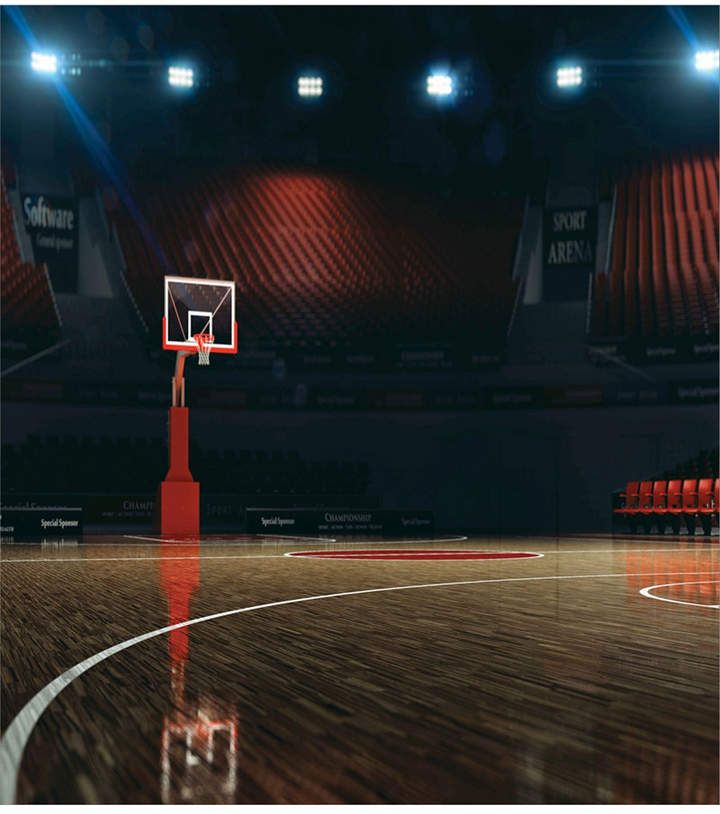
FIBA Basketball Court DimensionsFIBA governs international basketball courts. The measurements for FIBA basketball courts differ from U.S. courts because of the difference between our Imperial measurements — feet and inches — and the more standard metric system.
FIBA courts are an even 28 meters long, which converts to almost 92 feet. The 15-meter width converts to just over 49 feet. The tip-off circle is a bit smaller as well, at 3.5 meters in diameter. This difference translates to a radius of about five feet, seven inches.
The key is almost the same size at 5.8 meters long and 4.8 meters wide. These numbers convert to within a few inches of 19 and 16 feet. The basket is 1.2 meters, or almost four feet, in from the baseline, which puts the foul line at 4.6 meters — 15 feet — away. The restricted area under the basket is 1.25 meters or just a shade more than four feet in radius.
The basket is still 10 feet off the ground, which means the biggest difference is the three-point line.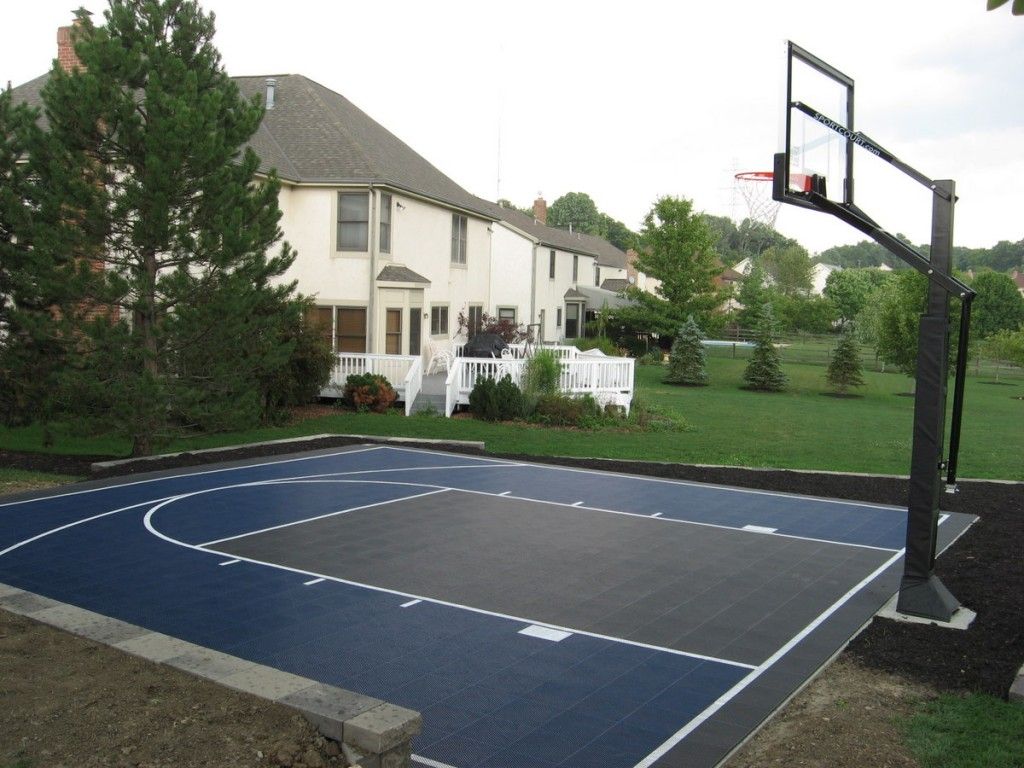 At the top of the arc, the three-point line is 6.75 meters from the center of the basket or 22.15 feet. This measurement works out to about 22 feet, two inches. The FIBA three-point line, which has also been adopted by the WNBA, is over a foot and a half closer than the NBA line.
At the top of the arc, the three-point line is 6.75 meters from the center of the basket or 22.15 feet. This measurement works out to about 22 feet, two inches. The FIBA three-point line, which has also been adopted by the WNBA, is over a foot and a half closer than the NBA line.
The History of Basketball Court DimensionsSince its invention in 1891, basketball’s court dimensions have varied. Let’s look at some of its historical changes, as well as answering that nagging question — “Why are basketball hoops 10 feet high?” — below:
The Story Behind the 10-Foot High Hoop
It would appear the 10-foot basketball hoop is the result of a careful calculation that considers the human anatomy and mechanics of the game. After all, even the tallest players today have to jump to dunk a ball, and a ten-foot high rim gives a comfortable target to shoot for at a distance. But as we see so often in history, the truth is much more mundane.
When James Naismith dreamed up the game in Springfield, MA in 1891, the railing he chose to hang the baskets on was ten feet off the ground. So, while everything else about the sport has changed since that first game, the baskets are still right where Dr. Naismith hung them.
So, while everything else about the sport has changed since that first game, the baskets are still right where Dr. Naismith hung them.
The History of the Three-Point Line
The three-point line is arguably the most recognizable aspect of a basketball court’s dimensions and part of the reason why is attributed to the history surrounding this semicircle.
The first instance of the three-point line appeared in the American Basketball League in 1961, a full 70 years after Dr. Naismith invented the game. The line was added to increase excitement, but the league folded in just one and a half seasons, so the idea never had a chance.
In 1967, the next competitor to the NBA arrived. The American Basketball Association, or ABA, instituted the three-point line from the very start, and it was a huge success. The ABA had many exciting innovations that produced a better product for the fans. But ultimately, there was not enough room for two professional basketball organizations, so the NBA and ABA merged in 1976.
The three-point line, however, was not included in the merger! The decision-makers in the NBA at the time were too stubborn to adopt such a radical change. They held out for three years before implementing the three-point line in the 1979-1980 season. The NCAA didn’t integrate it until 1986, and it didn’t arrive on high school basketball courts until 1987.
That isn’t the end of the story, however. The line was moved closer for three seasons in the ‘90s to try to boost scoring, but it was quickly moved back to its original place. Taking the idea to the extreme, the NBA has even admitted to having discussions about a four-point line. Ultimately, we’ll believe it when we see it.
The Original Cage Matches
In the early days of professional basketball, the game was played inside an actual cage. The reasons were more about practicality than about safety. The rule for who got to inbound a ball that left the court was “whoever got to it first,” so organizers took to putting up a cage so the ball could never go out of bounds in the first place.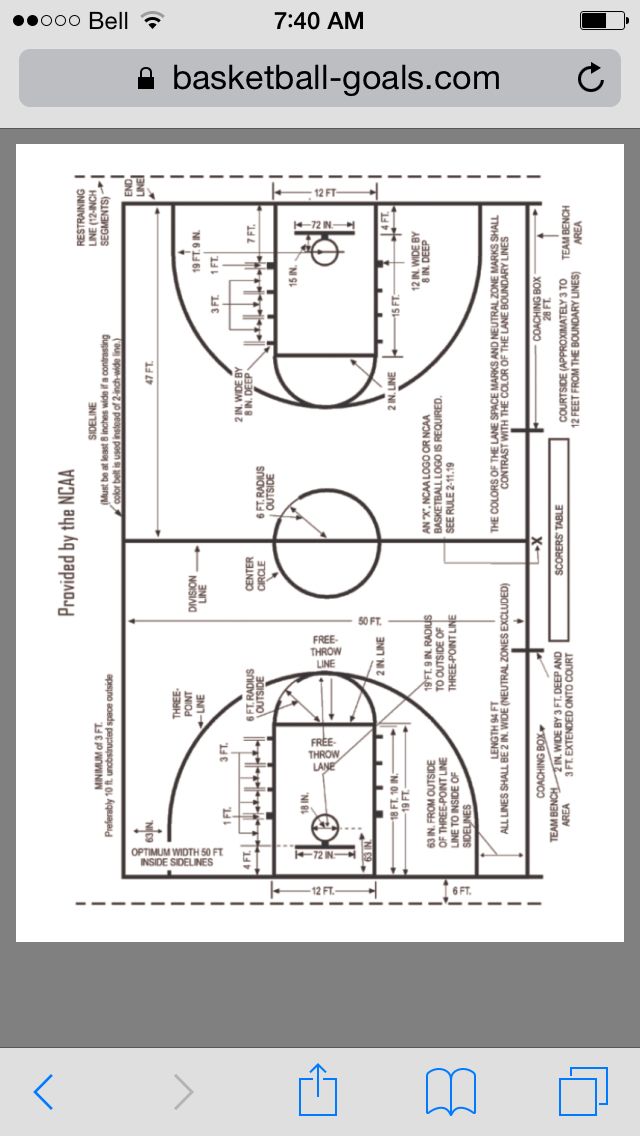
Those first basketball courts were about a third smaller than they are today, and the cages provided a physical boundary and an extra immovable for savvy teams. Could you imagine how much different the game of basketball would be today if those cages had stuck around?
The Alternative Key Designs
Today, basketball courts at all levels share a common design for the key — a rectangle measuring either 19 feet by 16 feet or 19 feet by 12 feet. However, this was not always the case. From the creation of FIBA in 1956 until 2010, the key was a trapezoidal design that was significantly wider at the baseline.
Another design of this feature is responsible for the name “key.” Have you ever thought about how a rectangular area under a basket got such a random name?
The reason is that the original area was much narrower, while the circle surrounding the free throw line was the same size. These two factors combined to create a shape that resembled an old-fashioned key.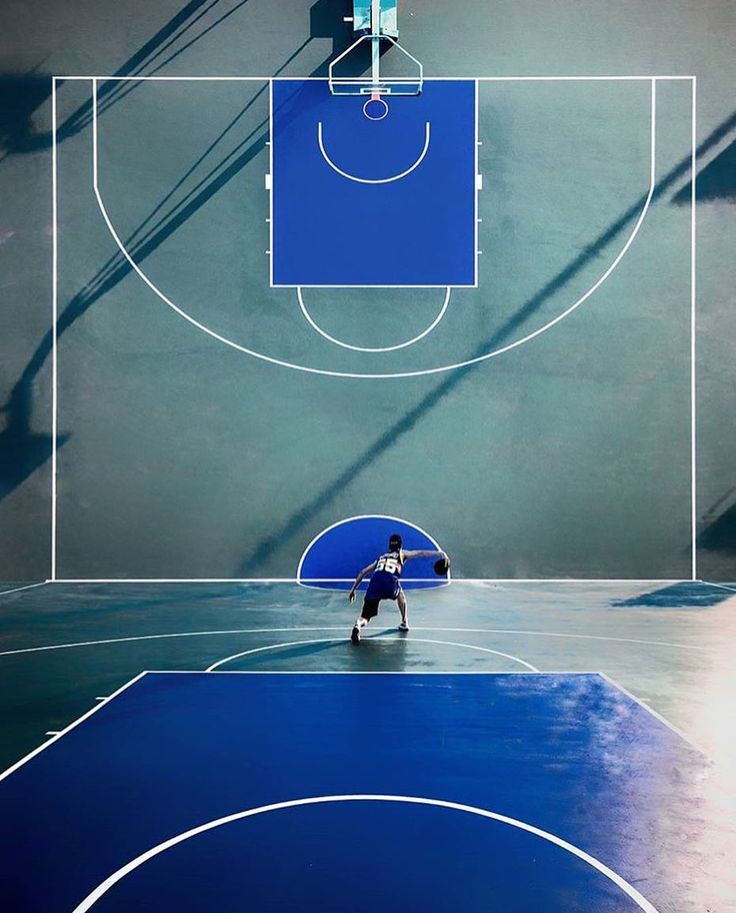 In 1951, the key was widened to 12 feet and later to the 16 feet we see now in the NBA and FIBA.
In 1951, the key was widened to 12 feet and later to the 16 feet we see now in the NBA and FIBA.
While the term lives on, time has erased any record of its design and original reference. And for the record, the official name for this feature is “free throw lane,” which isn’t a phrase many of us hear often.
And that’s a wrap on the history of basketball’s court dimensions.
Build Your Basketball Court With PROformancePerhaps you don’t have 94 feet of flat asphalt or indoor floor space. Don’t worry, because residential half court setups can be just as fun. And whether you are looking to paint your court or apply a pre-made solution, sticking to the official dimensions will take your pickup games to the next level.
Take a look at our selection of goals, nets and accessories to bring your home’s court together. You’ll have a hard time dragging your kids off the court as they spend hours posting up like Boogie, slashing like LeBron and launching it from deep like Steph.
Basketball Court Dimensions, Gym Size, Hoop Height
Basketball court dimensions and size vary based on the level of play. To help explain the various sizes, we’ve created a chart and diagrams that should help you. And we’ve organized the material into a helpful question-and-answer format.
What is a basketball court size?
Well, it depends on each court you measure — but there are some standards. The age of the players who will be the primary users and budgets are considerations for court builders.
Basketball Court Dimensions
Regulation basketball court dimensions are 94 feet long by 50 feet wide.
Basketball court size varies depending on the league and level of play. The court measures 94 feet long by 50 feet wide for NBA court dimensions and WNBA and college. Note the paint area – the free throw lane – is 16 feet across. The foul line is 15 feet from the face of the backboard and 2 inches wide.
International Basketball Federation (FIBA) and Olympic basketball courts call for the court to be slightly smaller at 91. 9 feet by 49.2 feet. In meters, that’s 28 by 15 meters.
9 feet by 49.2 feet. In meters, that’s 28 by 15 meters.
NBA Court Dimensions Diagram
High school basketball court dimensions
The high school and junior high basketball gym courts measure 84 feet long by 50 feet wide. Court markings reflect those dimensions.
You might like Kawhi Leonard Profile.
High School Basketball Court Diagram
At a younger level of play than college or pro, the court length is 10 feet shorter at 84 feet.
Read all about Larry Bird: Boston Celtic, Star Shooter (and Trash Talker)
How long is a basketball court?
So, what are court dimensions in feet? The high school court is 84 feet long. The length of an NBA court is exactly 10 feet longer. College and professional league games, including the WNBA, are played on a 94-foot-long court.
One of the most famous college facilities is Pauley Pavilion, where the UCLA Bruins play.
Visit: Stephen A. Smith Profile.
College Basketball Court Diagram
What are court dimensions in meters?
The metric size of a professional court is 28.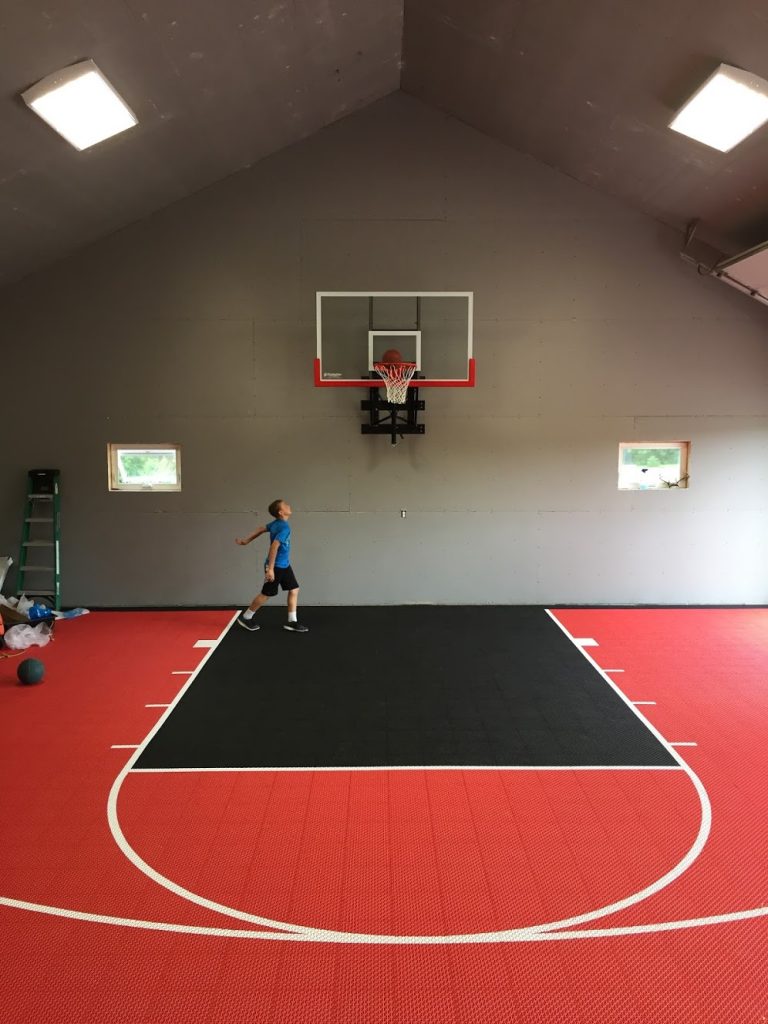 65 meters long by 15.24 meters wide. The high school court measures 25.6 meters long.
65 meters long by 15.24 meters wide. The high school court measures 25.6 meters long.
What are half-court dimensions?
Half-court dimensions are 47 feet long for the pros and 42 feet long for high school.
See Basketball Roles and Responsibilities of Each Position.
What are the half-court dimensions for a backyard?
Youth half-court dimensions are usually 42 feet long by 37 feet wide. High school half courts are slightly larger, 50 feet long by 42 feet wide.
Check out Ben Simmons Profile.
What are backyard court dimensions?
Backyard courts can be whatever size you wish (or can fit), but typically they are 90 feet long by 50 feet wide.
What are youth court dimensions – Middle School and High school?
The middle school court size is 74 feet long by 42 feet wide. High school courts are slightly larger, at 84 feet long by 50 feet wide.
Looking for a basketball court in your area to play? Check out The Original Basketball Court Finder.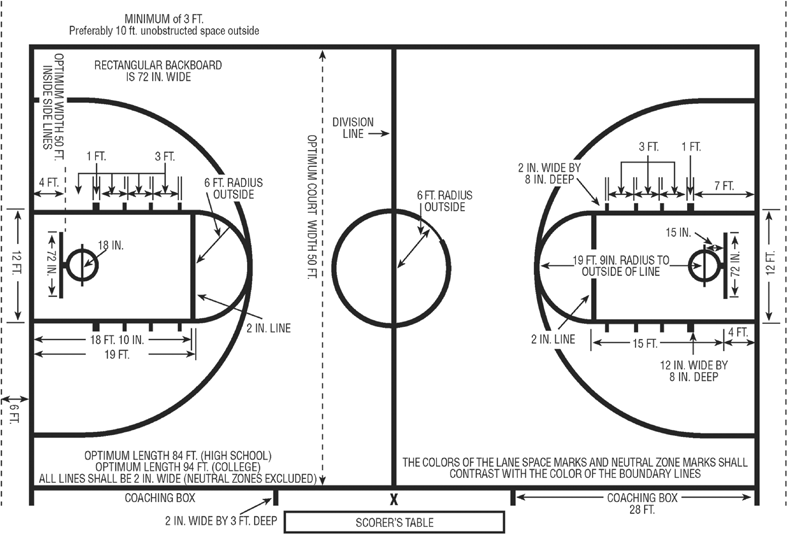
Basketball Hoop Height and Size
It’s critical that you set the goal at the proper height. Here are your guidelines.
See How many teams make the NBA playoffs?
What is the regulation basketball rim height? How tall is a hoop?
The distance from the gym floor to the rim is 10 feet. This rim height is the same for Junior High, High School, NCAA, WNBA, FIBA, and the NBA. Some kids’ leagues will lower the hoop to 8 feet or 9 feet to acknowledge that younger kids have difficulty shooting at ten feet-high hoops.
You might like Jumbotron Dancer Entertains Celtics’ Crowd.
How wide is an NBA basketball hoop? What is the NBA rim size?
The rim size is the same for all game levels – junior high, high school, NCAA, WNBA, NBA, and FIBA – at 18 inches in diameter.
Basketball Free Throw and 3-Point Distance
Read the guidelines below carefully, as the three-point distance varies by player.
What is the free-throw line distance? How far is the free-throw line?
The free-throw line is measured from the shooting line that intersects the key to the floor directly underneath the backboard.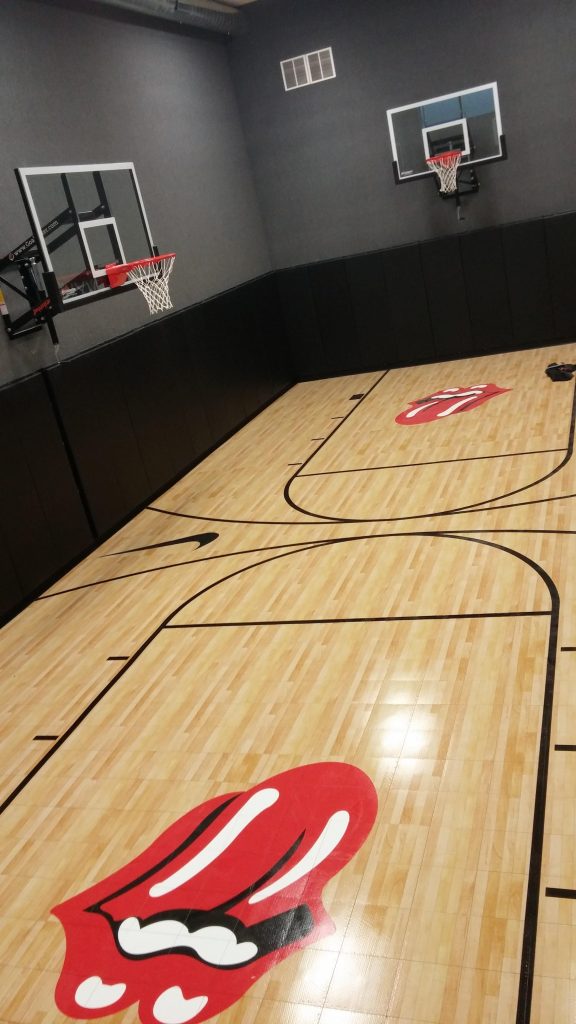 The free throw distance in the NBA, WNBA, and NCAA is 15 feet.
The free throw distance in the NBA, WNBA, and NCAA is 15 feet.
Did you know that Steve Nash was the best percentage shooter of free throws in the NBA? He shot 90.43% from the line making 3,060 of 3,384 attempts.
What is the high school 3-point line distance?
The 3-point line for high school is 19.9 feet from the basket.
What is the college 3-point line distance?
The 3-point line for both NCAA men and women is set at 20 feet, 9 inches from the hoop.
What is the WNBA 3-point line distance?
The WNBA 3-point line is 22.15 feet from the basket. From the corners, the distance is 21.65 feet.
What is the NBA 3-point line distance?
The pros shoot 3-pointers from beyond the arc, 23.75 feet from the basket. From the corners, the distance is 22 feet.
Check out Basketball Slang.
Size of the Basketball
Matching the size of the basketball to the player’s hand size makes a difference.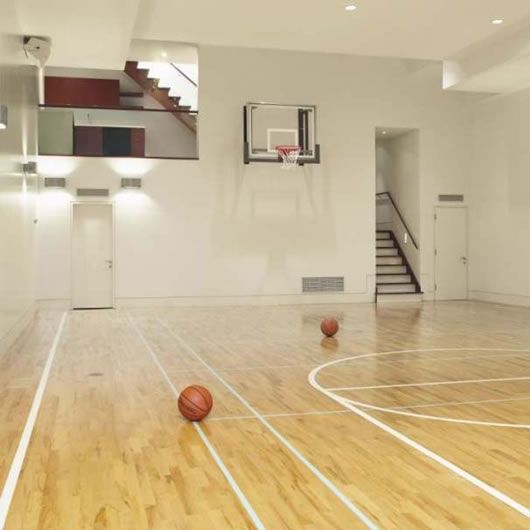 Read on.
Read on.
What are the ball’s diameter and circumference?
The size of the ball is different for men’s, women’s, and youth leagues.
For the NBA, men’s college, and boys ages 15 and up, players play with a 9.43-9.51 inch diameter (the width measured left to right) basketball. The ball’s circumference (the distance measured around the outside) is 29.5 inches. The official NBA game ball is made by Spalding and measures 9.43-9.51 inches in diameter or 29.5 inches (75cm) in circumference.
NCAA women and the WNBA use a slightly smaller ball with a roughly 9.07-9.23 inch diameter and 28.5-inch circumference.
The ball used in boys’ youth leagues has a 28.5-inch circumference. Girls’ youth basketballs are 27.5 inches in circumference. Kids 5 to 8 years old use the smallest ball at 25.5 inches in circumference.
Backboard, Baseline, and Key
The backboard is four feet out from the baseline, marking the end of the players’ active playing surface.
The key is 16 feet wide and 19 feet from the foul line to the baseline.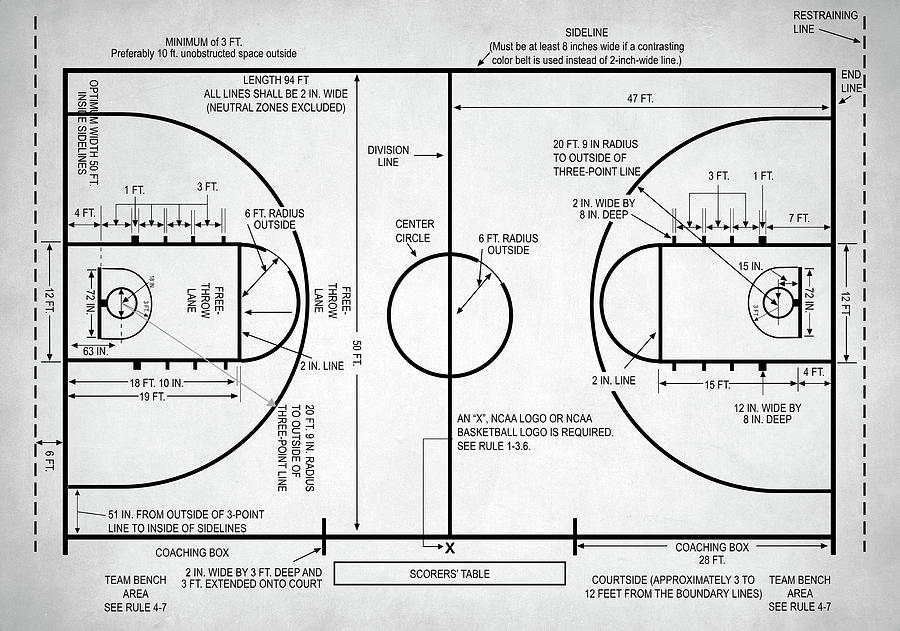
Inside the key, a four-foot arc is designated to align with the center of the basket to mark the restricted arc. If a defender is within this arc, they cannot draw a charging foul.
Regulation backboards are six feet wide and 42 inches tall.
Free throw markings
Short lines are drawn three feet apart along both sides of the key area to designate the standing positions for rebounders when a free throw is being shot. The first line is drawn seven feet from the baseline.
A six-foot arc (half circle) starting from the free-throw line away from the basket completes the key area.
Core components of basketball courts
Baskets, free-throw lines, three-point arcs, and the half-court line are some of basketball courts’ foundational elements. Court lines mark 94 feet in length by 50 feet in width for NBA courts. The half-court line is at 47 feet. Indoor courts are frequently made of hardwood-like polished maple. Outdoor courts may be composed of asphalt, concrete, or other pavements.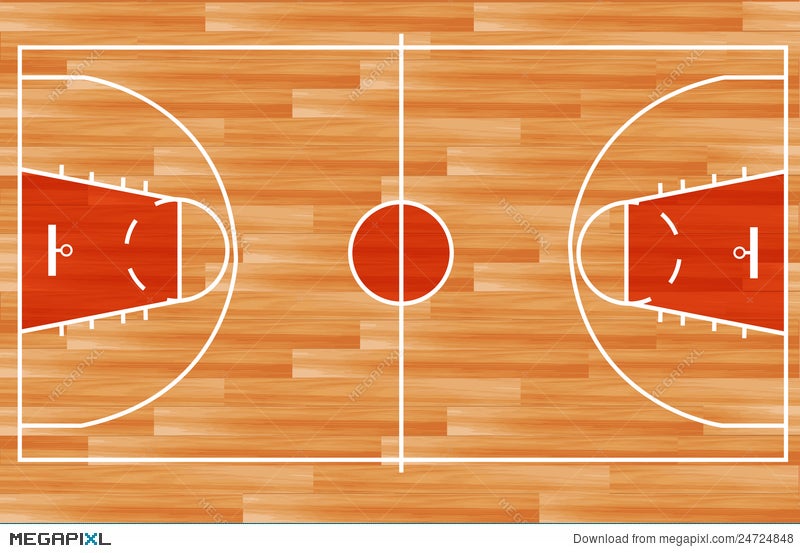
The words baseline and end line both refer to the ends of the court running behind the goals.
In the middle of the half-court line is a tip-off circle that has a six-foot radius. This is where the opening jump ball takes place.
The backcourt refers to the half of the court where the team’s basket is defended. The boundary lines include their end line, sidelines, and the half-court line of the playing court.
For international play, the standard court size is 28m long and 15m wide, measured from the inner edge of the boundary line.
The 3-Point line
The NBA 3-point arc is 22 feet to the center of the rim. Women’s and Men’s college basketball court features a 3-point arc of 20 feet 9 inches. High school basketball courts have a 3-point arc that is 19 feet 9 inches away from the center of the rim.
Great Basketball Courts Everyone Should See
Rucker Park in Harlem, New York. Where street legends go to make their name. Home of Kareem Abdul Jabaar, Nate Archibald, and Connie Hawkins.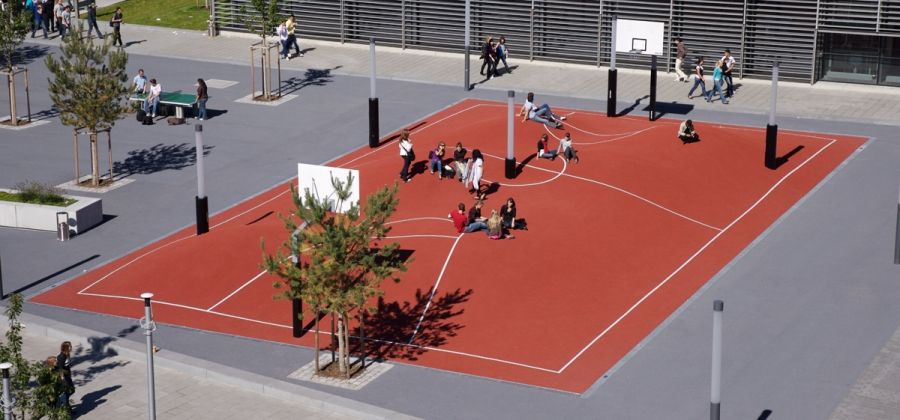 Even Kevin Durant and Kobe Bryant have made appearances.
Even Kevin Durant and Kobe Bryant have made appearances.
United Center, Chicago, Illinois. Michael Jordan won 6 NBA titles while calling this his home court.
Hoosiers Gym in Knightstown, Indiana. Gene Hackman + Dennis Hopper + Picket Fence = the best basketball movie ever.
Pauley Pavilion in Los Angeles, California. Home to the UCLA Bruins and John Wooden’s greatest college hoops dynasty.
Madison Square Garden, Manhattan, New York. Home of the Knicks with a household name that needs no introductions.
The Staples Center in Los Angeles, California. One word: “Showtime!”
The Swim Gym, Beverly Hills High School in Los Angeles. Remember “It’s a Wonderful Life” and the retractable gym floor? This is the place. Built in 1939, a 25-yard pool was placed under the gym floor. It’s a Wonderful Life was a 1946 movie.
Timing of a Game
Here are the total game times for basketball games for each level of play. Remember that time-outs, TV breaks, half time, and other play stoppages will draw out the real-time of a game 2 to 3 times longer than the timed play.
How long is a high school game?
High school basketball games consist of four 8-minute quarters for 32 minutes of game time.
Length of the college basketball game?
In the NCAA, college games consist of two 20-minute halves for 40 minutes of game time.
How long is a WNBA basketball game?
WNBA basketball games consist of four 10-minute quarters for 40 minutes of game time.
Length of an NBA basketball game?
NBA games consist of four 12-minute quarters for 48 minutes of game time.
How long is the shot clock?
The shot clock requires offenses to shoot before a timed period runs out. If a shot is not made during that period, a shot clock violation is called, and the ball is turned over to the opposing team.
In high school games, the shot clock varies. For men’s college hoops, the shot clock is 35 seconds, and for women’s college is 30 seconds.
The WNBA shot clock is 30 seconds, while the NBA limits the shot clock to only 24 seconds.
Basketball Court Fun Facts
Do you know everything about hoops courts? Try answering these trivia questions.
1.) What type of wood is used for NBA courts?
Maple is selected for its hardness and light color. The lightness helps provide contrast to the ball to follow the action in person and on TV. The lighter color reflects light better, too.
2.) How often does the NBA require teams to replace the floors in the arenas?
Every ten years. But, sometimes, a team receives a waiver if the floor is still in great shape.
3.) What three NBA teams were ranked the highest in appearance by the Chicago Tribune?
Charlotte Hornets, Brooklyn Nets, and Boston Celtics floors were ranked the highest by a panel selected by the newspaper.
By Greg Johnson & Mike O’Halloran
Greg is a designer and writer based in Minneapolis, Minnesota. Mike has authored three books on basketball coaching and has coached ten different teams.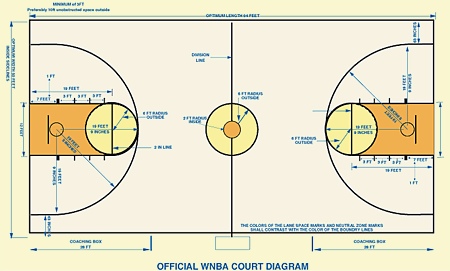
You’re on our Basketball Court Dimensions page.
Further Reading
Hoops Quotes
Slogans
NBA Players By The Numbers: Wingspans, Verticals, Hand Sizes
Fun Basketball Games For Kids to Improve Shooting
Basketball court markings: standards and norms
Author of the article
Khvatkov Dmitry
Consultant in the production of rubber coatings
Basketball field marking requirements are approved by the FIBA standard. The site must be flat with a hard surface, free of bends, cracks and other obstacles. The accepted dimensions of the field are 28 m long and 16 m wide. By NBA standards, the field is slightly larger: 28.7 m (94' ft) long and 15.3 m (50' ft) wide.
Areas not intended for international competitions may differ from accepted standards (for public use, in schools or universities, etc.) and usually vary from 20 to 28 m in length and from 12 to 16 m in width.
Basketball Court Marking Standards
Basketball court markings are conventionally divided into 5 components:
- Boundary lines.
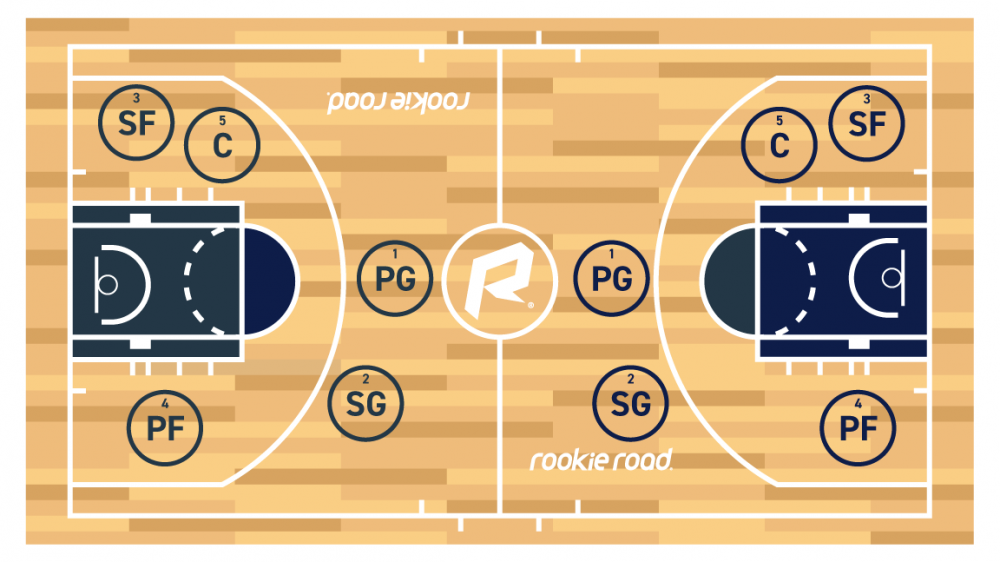 They are located along the perimeter of the site and set its size. The lines that run along the field are called side lines, and those that are behind the baskets are called front lines.
They are located along the perimeter of the site and set its size. The lines that run along the field are called side lines, and those that are behind the baskets are called front lines. - Central line. Divides the court in half parallel to the front lines.
- Central zone. It is a circle and is placed in the middle of the center line, and, accordingly, in the center of the entire field.
- Three-point line. It is a semi-ellipse and is located around the shields on both sides of the field. It limits the close range.
- Free throw line. It is located in front of the boards parallel to the front line and is limited on the sides by paint lines.
The standard line width is 5 cm. All outlines and lines must be of the same color (usually white) and be clearly visible from anywhere on the court.
Common lines
Common lines are used to limit the playing area of the court. The side lines (along the field) according to FIBA standards should be 28 m long, and the front lines - 16 m.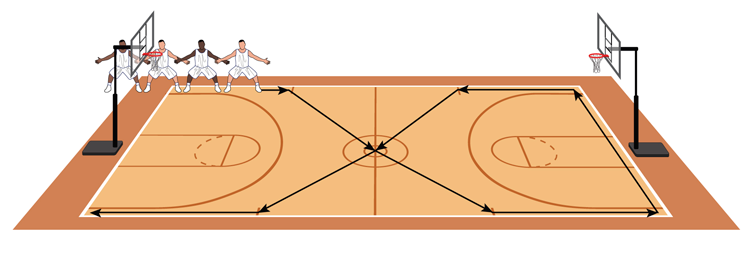 For public areas, deviations from the accepted standards are allowed. Typically, basketball courts in schools or gyms are made from 20 m long and 12 m wide.
For public areas, deviations from the accepted standards are allowed. Typically, basketball courts in schools or gyms are made from 20 m long and 12 m wide.
Central lines
The center line is parallel to the front and divides the field exactly in half. According to the standards - it should extend beyond the side lines by 15 cm on both sides.
In the middle of the center line there is a circle with a diameter of 3.6 m, which limits the central zone of the field. In this zone, the ball is played at the beginning of the game.
Three-Point Line
Three-Point Lines are located around the backboards on both sides of the field and consist of two straight lines 2.9 long9 m and a semicircle. Straight lines run perpendicular to the front at a distance of 0.9 m from the side lines. Despite the fact that visually the distance from the ring to the side of the three-point line seems to be less than to its central part, the distance from the backboard to any point is 6.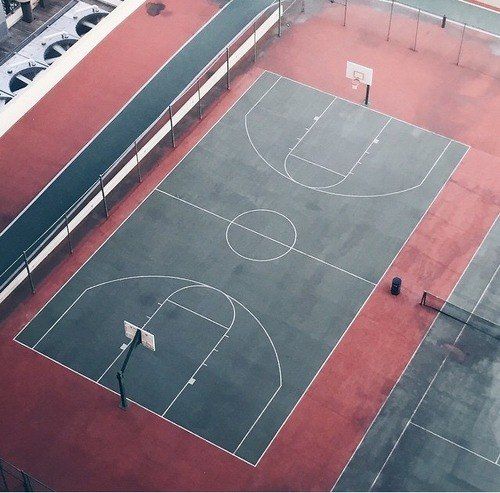 75 m.
75 m.
Penalty lines
Penalty lines limit the nearest area at the backboard. They consist of a trapezoid and a free throw zone.
Despite the name, the "trapezium" is a rectangle (until 2009year it really was a trapezoid), which is located under the shield. Its dimensions are 5.8 meters long and 4.9 meters wide. The shield is located at a distance of 1.575 m from the end line in the middle of the site. In front of the backboard, at a distance of 1.25 m, there is a semicircle that limits the area for picking up the ball.
At a distance of 4.225 meters from the backboard, the trapeze zone ends and the free throw zone begins. It is a semicircle with a diameter of 3.6 m (like the central circle).
Paint zone lines
These lines are serifs on both sides of the trapezoid (parallel to the side lines). They limit the areas for players who are fighting for the ball during a free throw.
Zones on the basketball field
The basketball court is divided into zones using markings. Each zone has its own specific rules.
Each zone has its own specific rules.
Center circle
The center circle is used as a separate kick-off area at the start of the game. One representative from each team stand in a circle from their side and fight for the ball in a jump, after it is dropped by the referee. All players are exclusively on their side of the field, except for one who rebounds on the opponent's side.
Neutral zone
The peculiarity of this zone is that as soon as the player of the attacking team with the ball crosses the center line and is on the side of the opponent, he cannot pass the ball to the player of his team who is on the other side of the field (i.e. behind center line on your side).
Three-point zone
The three-point line limits the near zone of the shot. Hitting the basket from outside the basket brings the team three points. If the throw was made inside the zone, then it brings two points.
Three-second zone
This is the zone in close proximity to the ring.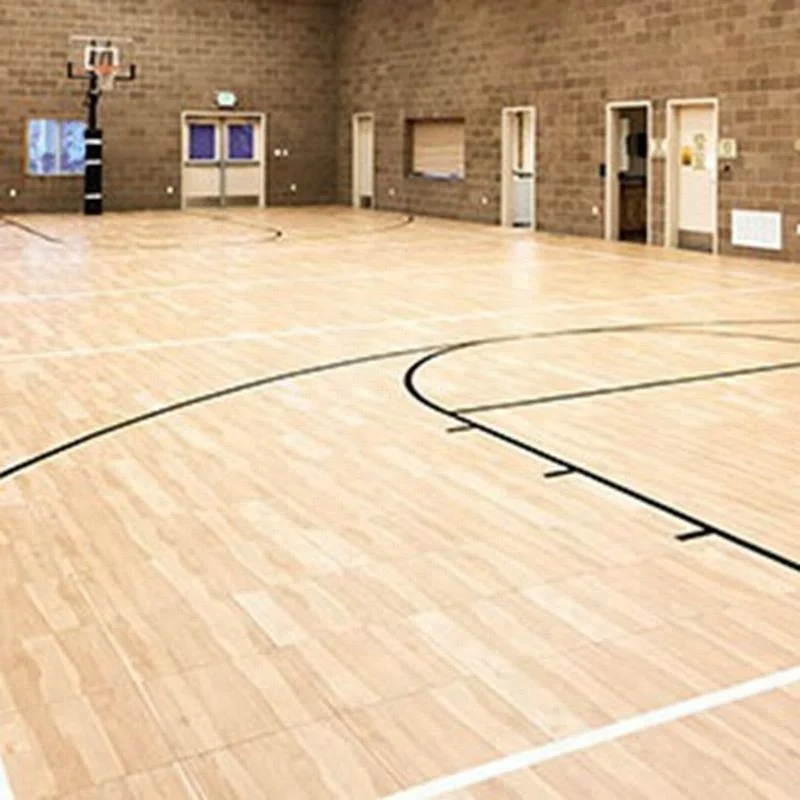 It is called three-second, since the player of the attacking team cannot be in it for more than three seconds. Most balls are thrown in this zone, so when attacking, it provides maximum protection.
It is called three-second, since the player of the attacking team cannot be in it for more than three seconds. Most balls are thrown in this zone, so when attacking, it provides maximum protection.
Free throw area
In controversial situations, a free throw is provided from this area. The player of the attacking team must score the ball without stepping over the line of the trapezoid. At the same time, the players of both teams are not in the three-second zone. They take up positions along the paint lines on the sides of the trapezoid and may not step outside the lines until the free throw shooter has shot the ball.
How to mark a basketball field?
Basketball field markings, whether it is an international competition court or an open-air amateur field, are best applied using special equipment. This will ensure the long life of the coating, the lines will not clog and will promote fair play.
You can order the marking of a basketball court in Moscow and the Moscow region from Rezkom. We will measure the premises and develop a design project for the field so that it complies with generally accepted rules and is convenient for operation. For more details, you can contact our manager by phone 8-495-64-24-111.
We will measure the premises and develop a design project for the field so that it complies with generally accepted rules and is convenient for operation. For more details, you can contact our manager by phone 8-495-64-24-111.
Construction of a turnkey basketball court|SportObject
The company "SportObject" offers its services in the construction of turnkey basketball courts. Trusting the construction of our company, you get a whole range of turnkey services, including design, ground work, laying the base and coating, marking and other construction work. We strictly adhere to the agreed deadlines and provide our clients with a work schedule that indicates the start and completion dates for construction.
Find out why it is safe to cooperate with us
Details
Calculation of the cost of the object
To find out the estimated cost of your object, select the options below or use the detailed calculator available by clicking the "Make a detailed calculation" button.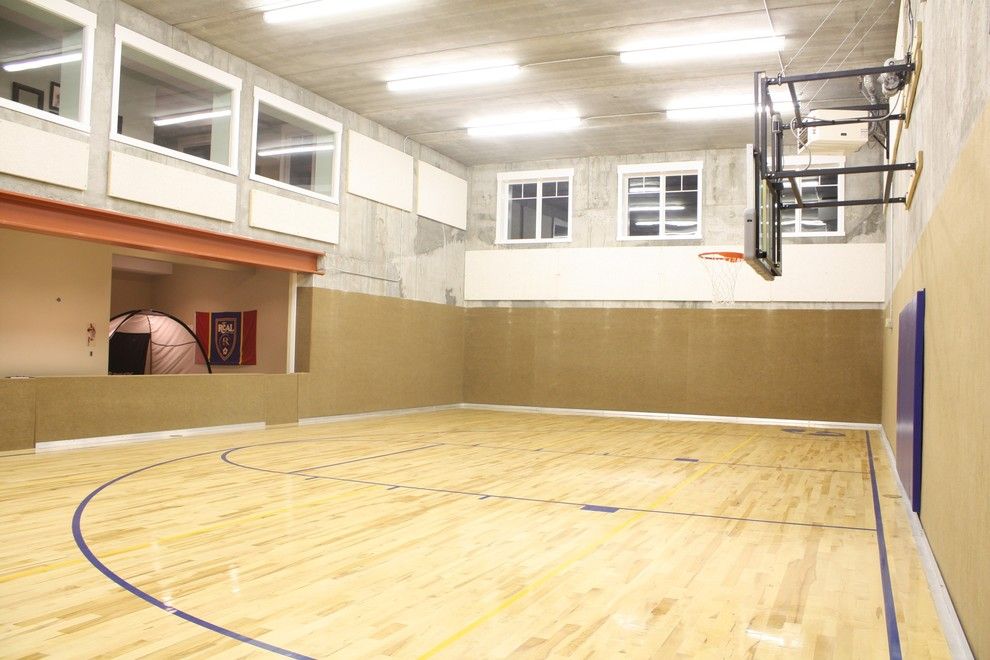
1. Coating:
Choose the type of coating for your object.
Not selectedAcrylicRubber crumbModular plasticPolyurethane
2. Destination:
Specify where your object will be used.
Not selectedFor suburban developmentsFor educational institutionsFor competitionsFor sports organizationsFor private business
3. Your object:
Specify whether your object is located: indoors, outdoors or it needs a hangar.
Not selectedOutdoor (outdoor)Indoor (indoor)To be built (prefabricated hangar)
4. Field sizes:
Select the appropriate field size from the provided list.
Not selectedCustomStandard30x18 - (playing dimensions 28x15) 34x19 - for competitions (playing dimensions 28x15)
Specify the parameters of your object in a detailed calculator and get an approximate cost of the service.
Budget savings
We help reduce your costs by up to 40% and avoid unnecessary overpayments.
Project in 3 days
We will design and calculate the exact cost of your object in just 3 days.
5 year warranty
We give great guarantees for imported goods and materials from our warehouse.
421 590* 421590 RUB
* The price is indicated for the basic package with a coating without a base. You can also use the detailed calculator.
Implementation example
Private sector basketball court
Difficulty:
Rubber slabs for outdoor sports grounds are perhaps the most reliable and rational option of all.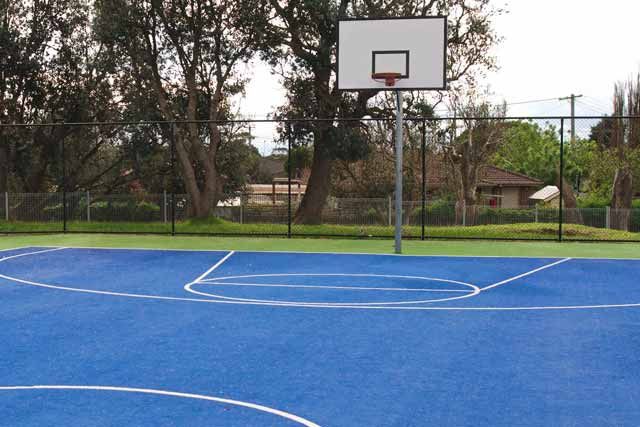 The coating is made of high-strength crumb rubber and a binding polymer (polyurethane adhesive).
The coating is made of high-strength crumb rubber and a binding polymer (polyurethane adhesive).
More details
Get a consultation
Request a call back and one of our managers will advise you on all your questions
You can also call
8 (495) 240-82-24
By submitting your personal data through the forms on the site, you give your consent to the processing of personal data in accordance with Federal Law No. 152-FZ "On Personal Data" dated July 27, 2006, as amended on July 1, 2017.
Stages of construction on the example of a football stadium
The thickness of the foundation pit and the amount of materials that are needed for your foundation, we select depending on the size of the field. We select drainage and other systems based on the regional location (how much precipitation is in your region, what kind of drainage is needed). Additionally, we equip drainage wells, or divert them to the drainage system.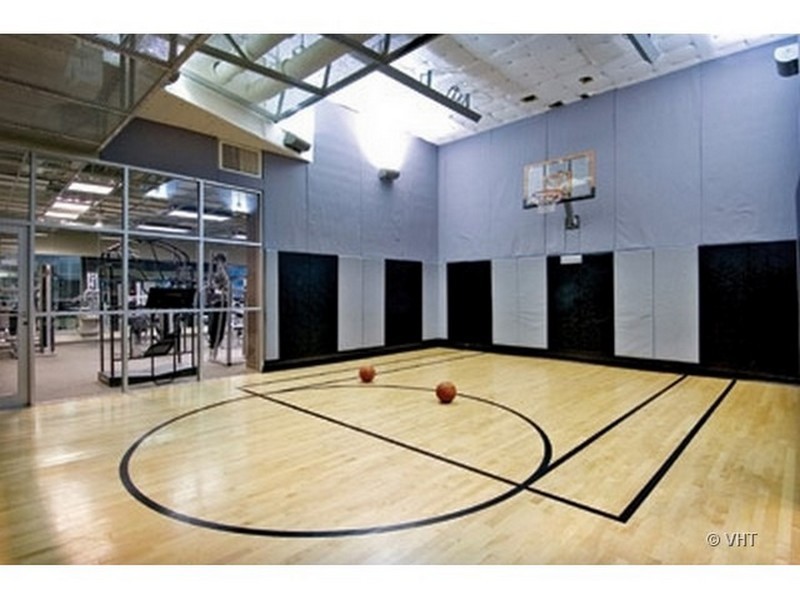 Field slopes of several different types depending on site operating conditions.
Field slopes of several different types depending on site operating conditions.
Preparation of excavation, sand bed, drainage system
The quality of a football field is more than half dependent on the quality of the base! Our base is a monolithic solid single layer, which over the years does not form any fractures, the soil does not go anywhere and remains flat throughout the entire period of operation. Relatively speaking, even if a tractor passes over the base, there will be no tire marks, because everything is solid and dense!
Sequential compaction of base layers
We carry out all types of additional improvement works: we can install a fence for you, pave an asphalt path to something, level the territory, paint walls, borders, etc. We will perform all the required related work!
Installation of the curbstone
The laying of the artificial grass itself is as important as the preparation of the base. When laying the field, an important aspect is gluing the rolls and cutting the markings.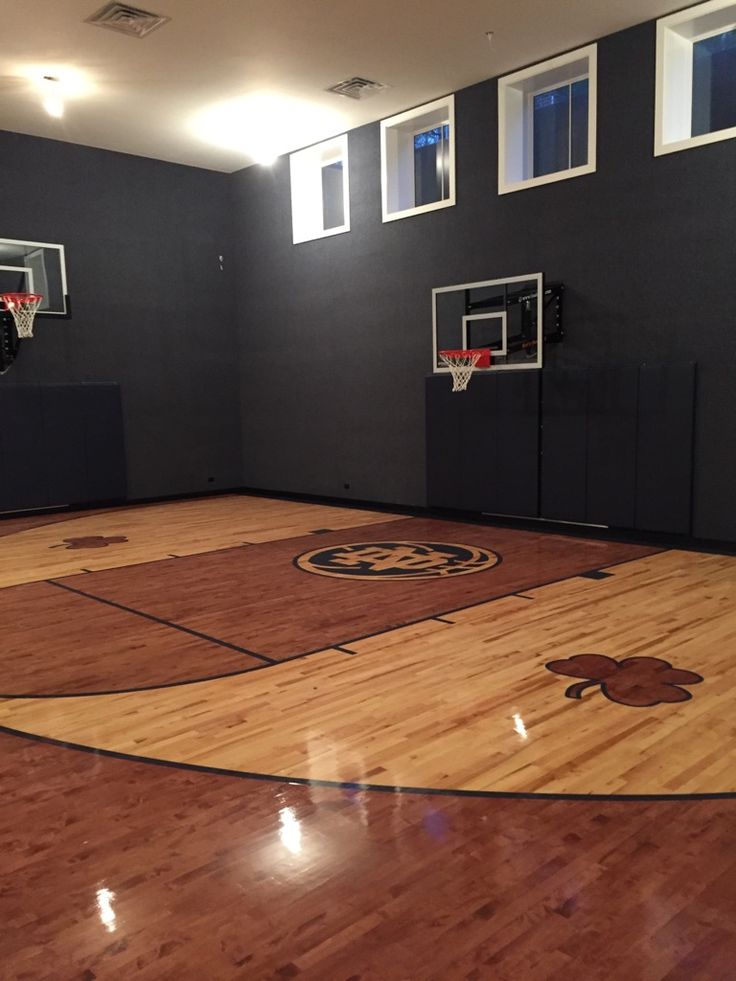 Gluing must be done securely. The material in the work requires getting used to, because the two-component glue rolls down after a while and they need to work quickly.
Gluing must be done securely. The material in the work requires getting used to, because the two-component glue rolls down after a while and they need to work quickly.
Laying the grass on the prepared base, gluing it and cutting the markings
Be sure to remember: the gate is installed with a safety requirement so that it does not turn over. Therefore, this aspect is given special importance. In this regard, the gate is either concreted or attached to an accompanying fence.
Installation of the goal
The backfill of a football field determines a large part of the performance of the game. The backfilling work is responsible, because the presence or absence of drops and bumps, which will eventually be felt during the game, depends on the uniform distribution of sand and crumb rubber on sports grounds. That is, there should be both an even base and a high-quality pile with an even distribution of backfill under it.
Raising grass, distributing sand and crumb rubber across the field
We cooperate with the largest manufacturers of stands, fences and other sports equipment in the Russian Federation. Therefore, if necessary, we can supply everything you need to the object at a wholesale price. We install all this equipment, advise in which cases which is better, etc. We can supply many things both in a finished version and make them ourselves on the spot.
Therefore, if necessary, we can supply everything you need to the object at a wholesale price. We install all this equipment, advise in which cases which is better, etc. We can supply many things both in a finished version and make them ourselves on the spot.
Installation of additional equipment (treadmills, jumping pits, safety fences, grandstands)
You can also be sure that we will carry out all the necessary arrangements for their improvement on the site and the adjacent territory.
Landscaping
The thickness of the foundation pit and the amount of materials that are needed for your foundation, we select depending on the size of the field. We select drainage and other systems based on the regional location (how much precipitation is in your region, what kind of drainage is needed). Additionally, we equip drainage wells, or divert them to the drainage system. Field slopes of several different types depending on site operating conditions.
Preparation of excavation, sand bed, drainage system
The quality of a football field is more than half dependent on the quality of the base! Our base is a monolithic solid single layer, which over the years does not form any fractures, the soil does not go anywhere and remains flat throughout the entire period of operation.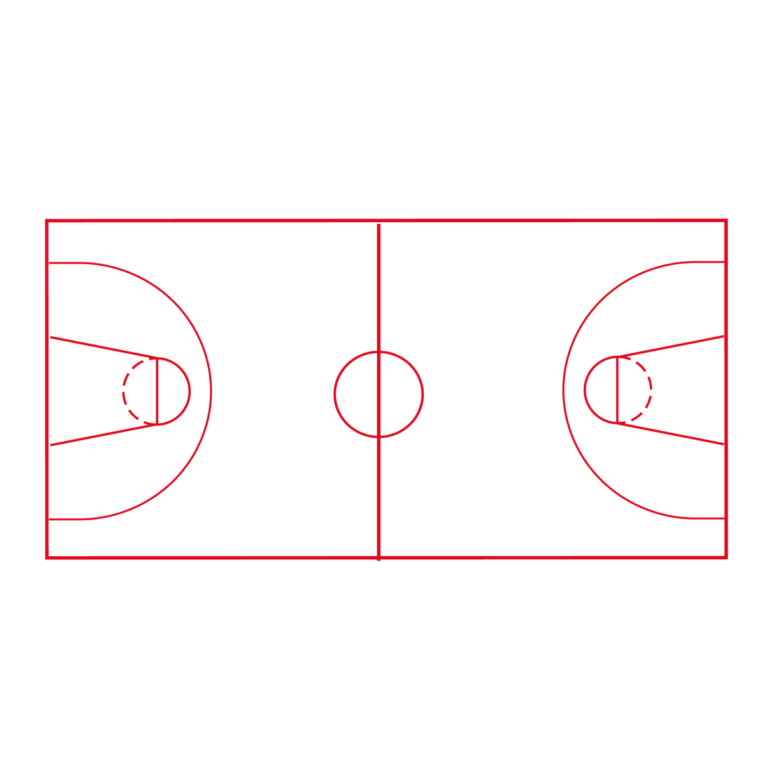 Relatively speaking, even if a tractor passes over the base, there will be no tire marks, because everything is solid and dense!
Relatively speaking, even if a tractor passes over the base, there will be no tire marks, because everything is solid and dense!
Sequential compaction of base layers
We carry out all types of additional improvement works: we can install a fence for you, pave an asphalt path to something, level the territory, paint walls, borders, etc. We will perform all the required related work!
Installation of the curbstone
The laying of the artificial grass itself is as important as the preparation of the base. When laying the field, an important aspect is gluing the rolls and cutting the markings. Gluing must be done securely. The material in the work requires getting used to, because the two-component glue rolls down after a while and they need to work quickly.
Laying the grass on the prepared base, gluing it and cutting the markings
Be sure to remember: the gate is installed with a safety requirement so that it does not turn over. Therefore, this aspect is given special importance. In this regard, the gate is either concreted or attached to an accompanying fence.
In this regard, the gate is either concreted or attached to an accompanying fence.
Installation of the goal
The backfill of a football field determines a large part of the performance of the game. The backfilling work is responsible, because the presence or absence of drops and bumps, which will eventually be felt during the game, depends on the uniform distribution of sand and crumb rubber on sports grounds. That is, there should be both an even base and a high-quality pile with an even distribution of backfill under it.
Raising grass, distributing sand and crumb rubber across the field
We cooperate with the largest manufacturers of stands, fences and other sports equipment in the Russian Federation. Therefore, if necessary, we can supply everything you need to the object at a wholesale price. We install all this equipment, advise in which cases which is better, etc. We can supply many things both in a finished version and make them ourselves on the spot.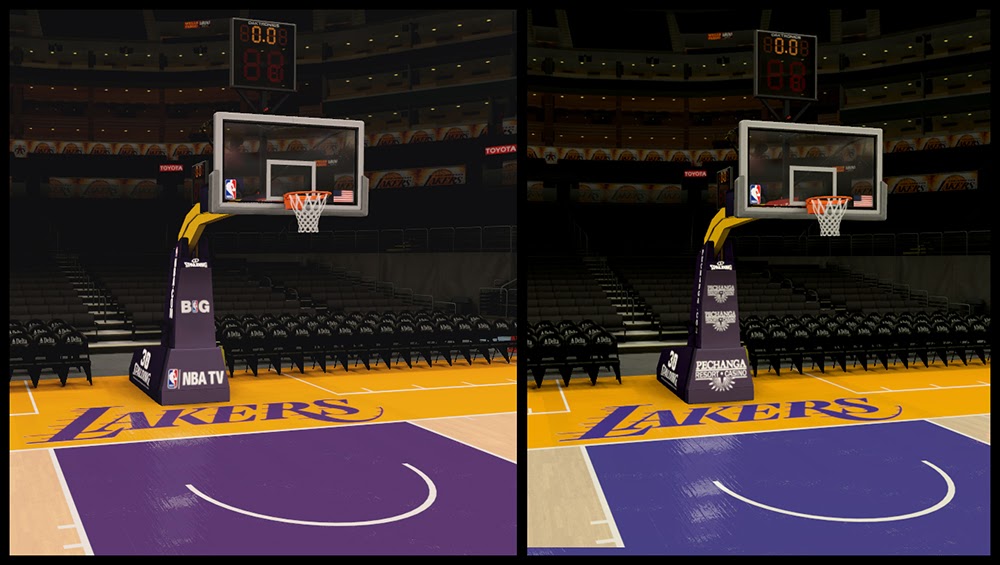
Installation of additional equipment (treadmills, jumping pits, safety fences, grandstands)
You can also be sure that we will carry out all the necessary arrangements for their improvement on the site and the adjacent territory.
Landscaping
Options
How do we work?0003
We carry out construction and installation works
We hand over the finished object and provide a guarantee
Private
I am a private client
We work in all regions of the Russian Federation
We cooperate with contractors who are ready to travel to any city in Russia. We take measurements, bring materials or buy them in your city, install coatings and equipment.
We offer standard solutions
We are engaged in the construction of both standard and unique projects. We work individually with each client: we take into account your wishes, fit into the budget and comply with the agreed deadlines.
We work individually with each client: we take into account your wishes, fit into the budget and comply with the agreed deadlines.
We take care of your budget
We help clients in the selection of materials, places for construction, provide detailed advice and suggest how to get a fully functional sports facility at a lower cost.
We create 3D visualization
We offer the development of a 3D model that will convey a complete vision of the concept of the future object. Also, this service will help both us and the client to eliminate the possibility of error at the design stage.
We make reconstruction and repair
We carry out all types of reconstruction works: we repair the foundation, lay the foundation, replace the coatings, install fences, roof structures, make glazing and ennoble the areas.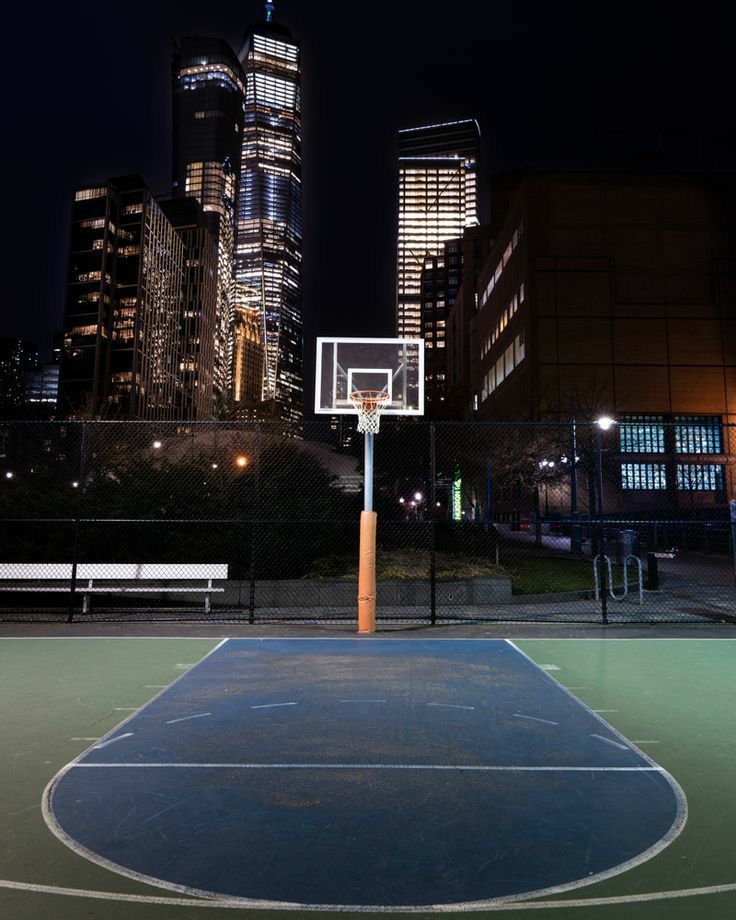
I am a frequent customer
Corporate
I am a corporate client
We offer additional services
We are engaged in maintenance of the facility after commissioning: we take care of the condition of sports surfaces, ennoble areas, do glazing and other general construction work.
We take on complex projects
We have enough experience and capabilities to solve the most non-standard and complex tasks. Many of our specialists took part in the preparation of sports grounds for the Olympic Games in Athens and the 2018 World Cup.
We cooperate with global companies
We maintain strong partnerships with well-known manufacturers from Europe and Asia. At the request of the customer, we supply the goods you like from abroad in the shortest possible time.
We provide detailed advice
We answer in detail all the client's questions about the project and our services. Also, we are ready to provide professional legal advice on construction issues.
We build turnkey facilities
We provide a whole range of services: designing an object, drawing up design estimates, building a foundation and base, selecting and laying coatings, erecting roofed structures, installing appropriate equipment and necessary communications.
Our clients
I am a corporate client
Acknowledgments and certificates of conformity
Company "SportObject" offers its services in the field of sports construction. We are engaged in the construction of turnkey basketball courts: we design, draw up design estimates, coordinate the construction, mount the foundation and roof structures, lay bases and coverings, perform finishing work, provide communications and deliver sports equipment.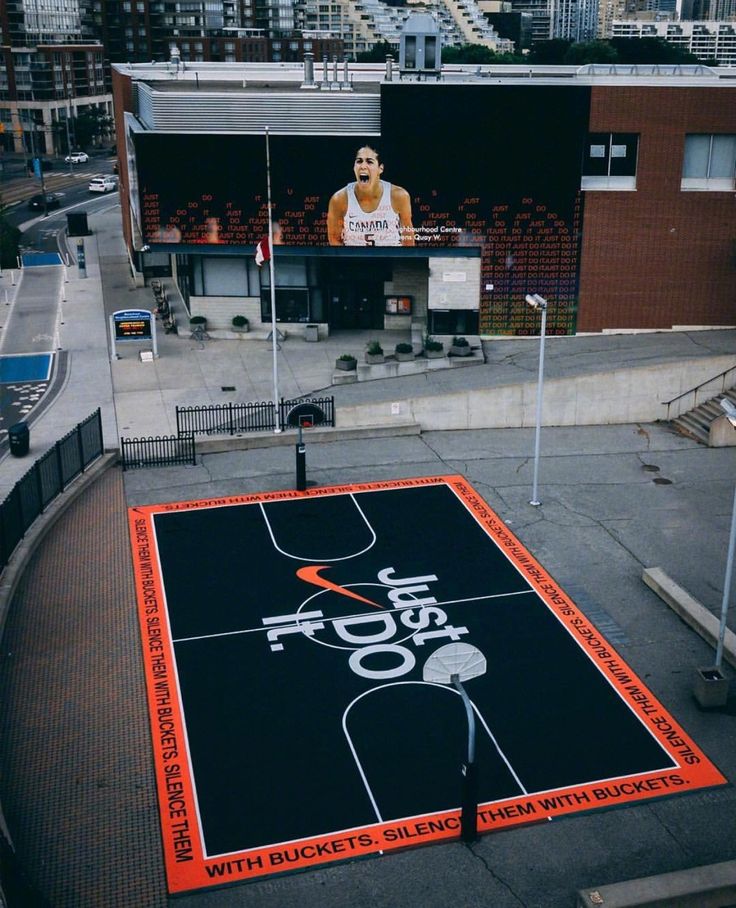 Each of the stages of work is implemented strictly according to the schedule agreed with the client, which allows us to deliver a fully finished project on time.
Each of the stages of work is implemented strictly according to the schedule agreed with the client, which allows us to deliver a fully finished project on time.
We value the trust of each customer and guarantee comfortable cooperation
- We travel to any place in Russia;
- We provide detailed advice on construction issues;
- We select high-quality solutions for the client's budget;
- We help with the choice of an advantageous place for construction;
- We work with complex and non-standard ideas;
- We offer creative solutions within a reasonable budget;
- We provide additional facility maintenance in other regions of Russia.
We supply basketball surfaces from world manufacturers
The dynamics of basketball matches means high speed, sudden movements and heavy loads on the joints. It is very important that the flooring of the basketball court is both wear-resistant and injury-proof at the same time.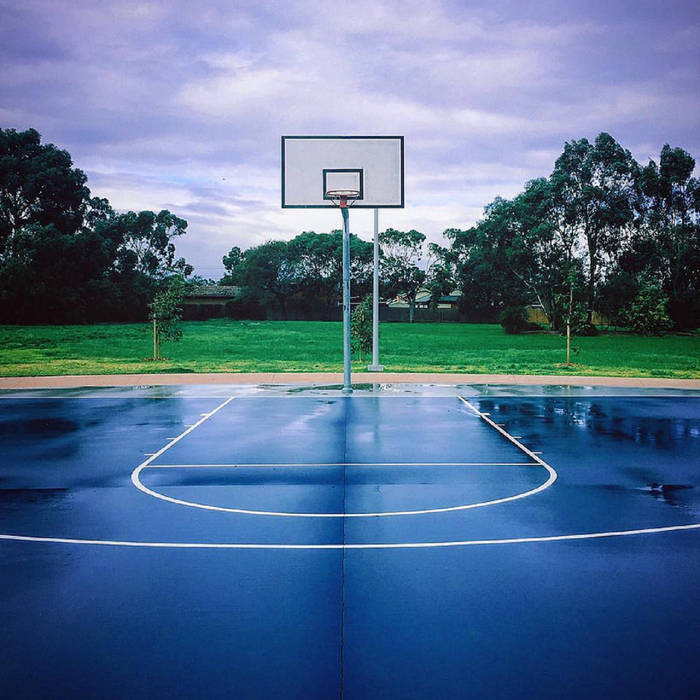 For basketball courts we offer: tennis, hard or soft-hard, modular plastic, polyurethane coating and crumb rubber coating.
For basketball courts we offer: tennis, hard or soft-hard, modular plastic, polyurethane coating and crumb rubber coating.
Our company only works with proven materials that have passed the strictest quality control, so we offer a wide selection of outdoor basketball surfaces from domestic and foreign manufacturers, such as: ERFOLG , BERGO , PLASTFACTO , Conica , Novol , Aropa , CRUMB , GUMBIT 9099 , MASTER FIBER and many more.
In addition to the construction of basketball courts, we take care of the complete set of the object and provide it with all the necessary equipment until it is ready for operation. In accordance with the requirements of the customer, any sports equipment can be installed: backboards, rings, stands of a certain capacity, running tracks, a sector for standing long jumps and, of course, various types of fences.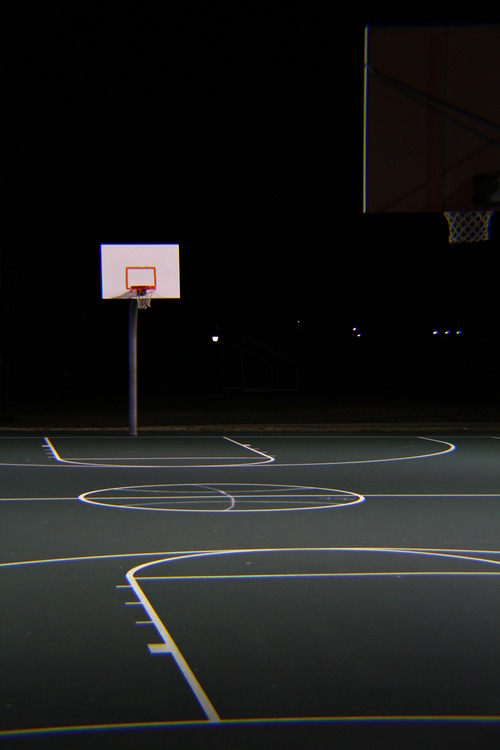
We offer metal railings or safety nets for the customer's choice
- Metal 2D and 3D fences are sectional structures of increased strength with rod diameters from 4 to 6 mm, protected by a polymer and zinc coating. Unlike other fences, mesh panel fencing is maintenance-free - it does not get dusty, does not fade in the sun and does not deform under wind loads, and also does not need periodic painting
- Protective mesh made of kapron or nylon threads can have different mesh sizes: 100x100, 40x40 or 20x20. Such a fence is ideal for zoning the playing space and protecting spectators from sports equipment. The mesh does not need maintenance and is easily restored
As we build new basketball courts, we also work with existing facilities that need a major overhaul or minor restoration. We are happy to undertake the design of a sports facility, without including construction work, and for the implementation of the facility according to a ready-made project.